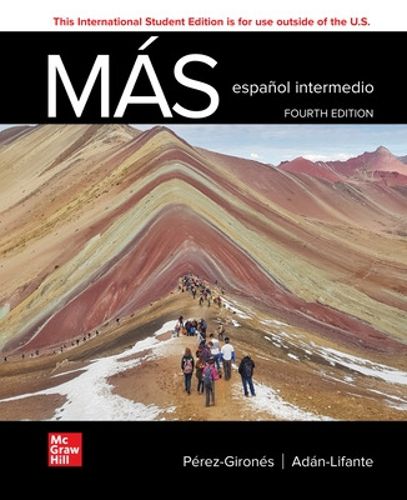Readings Newsletter
Become a Readings Member to make your shopping experience even easier.
Sign in or sign up for free!
You’re not far away from qualifying for FREE standard shipping within Australia
You’ve qualified for FREE standard shipping within Australia
The cart is loading…






Students at the Intermediate level enter with varying degrees of background knowledge. Despite this variation in experience and students’ rate of progress, faculty and programs have an expectation that all students achieve communicative benchmarks/goals at the end of the Intermediate course or sequence. MAS, third edition, provides numerous tools to address these concerns, namely:
LearnSmart: McGraw-Hill’s adaptive learning tool has been proven to significantly enhance students’ learning and improve course outcomes. Well-scaffolded communicative activities: Scaffolding within individual activities and activity sequences throughout the program supports all students in filling in knowledge gaps and making progress from input to output.
Task-based activities: Faculty and students report that the cultural and contextual-based activities integrated throughout MAS provide students with real-world applicable language skills that engage students and prepare them for Spanish use outside a classroom setting.
Programs have increasing difficulty recruiting and retaining students at the intermediate level due to an overall decline in college enrollments and in some cases the lowering or elimination of language requirements. These trends result in departments having to market their language courses to entice students and maintain enrollments. MAS, third edition, helps faculty with this issue by providing the following.
An integrative cultural approach: Faculty and students describe MAS as presenting language through a cultural lens. This integrated approach motivates and appeals to students as they navigate engaging cultural and historical contexts while they strengthen their language skills. Additionally, many faculty reports that MAS presents interesting chapter themes that catch students’ attention.
A focus on real-world language: Throughout MAS, language is consistently demonstrated as used by native speakers. The extensive selections of written and aural input include readings, videos, cartoons, graphs, quotes, and popular sayings from the Spanish-speaking world, serving to ground students in the authentic language experience. Additionally, the learning activities encourage students to produce real-world language that has applicability far beyond the classroom environment.
Engaging media: Throughout MAS, students experience the types of video and film content that represent the variety of media they interact with in their free time. Careful attention has been paid to selecting video resources that are engaging to students and that serve as a springboard to additional conversation and writing practice for students.
$9.00 standard shipping within Australia
FREE standard shipping within Australia for orders over $100.00
Express & International shipping calculated at checkout
Students at the Intermediate level enter with varying degrees of background knowledge. Despite this variation in experience and students’ rate of progress, faculty and programs have an expectation that all students achieve communicative benchmarks/goals at the end of the Intermediate course or sequence. MAS, third edition, provides numerous tools to address these concerns, namely:
LearnSmart: McGraw-Hill’s adaptive learning tool has been proven to significantly enhance students’ learning and improve course outcomes. Well-scaffolded communicative activities: Scaffolding within individual activities and activity sequences throughout the program supports all students in filling in knowledge gaps and making progress from input to output.
Task-based activities: Faculty and students report that the cultural and contextual-based activities integrated throughout MAS provide students with real-world applicable language skills that engage students and prepare them for Spanish use outside a classroom setting.
Programs have increasing difficulty recruiting and retaining students at the intermediate level due to an overall decline in college enrollments and in some cases the lowering or elimination of language requirements. These trends result in departments having to market their language courses to entice students and maintain enrollments. MAS, third edition, helps faculty with this issue by providing the following.
An integrative cultural approach: Faculty and students describe MAS as presenting language through a cultural lens. This integrated approach motivates and appeals to students as they navigate engaging cultural and historical contexts while they strengthen their language skills. Additionally, many faculty reports that MAS presents interesting chapter themes that catch students’ attention.
A focus on real-world language: Throughout MAS, language is consistently demonstrated as used by native speakers. The extensive selections of written and aural input include readings, videos, cartoons, graphs, quotes, and popular sayings from the Spanish-speaking world, serving to ground students in the authentic language experience. Additionally, the learning activities encourage students to produce real-world language that has applicability far beyond the classroom environment.
Engaging media: Throughout MAS, students experience the types of video and film content that represent the variety of media they interact with in their free time. Careful attention has been paid to selecting video resources that are engaging to students and that serve as a springboard to additional conversation and writing practice for students.